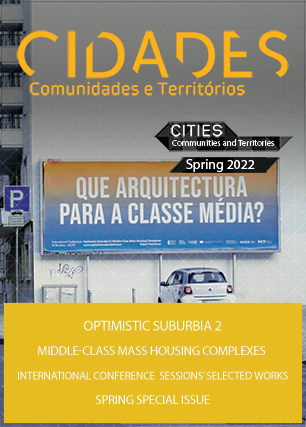From an imagined community to genuine communities
Birth and development of Etrimo Apartment Buildings in Brussels, 1950–2020
Mots-clés :
Etrimo, collective housing, home ownership, inhabitants' community, BrusselsRésumé
Using an analysis of apartment buildings built in Brussels by the real estate developer Etrimo between 1950 and 1970, we investigate the ability of collective housing to build and support an inhabitants’ community.
After World War II, Etrimo took advantage of the poor state of existing housing stock and the return of Belgian families from Congo to intensify its production of apartment buildings for aspiring middle-class homeowners. These buildings consisted of repeated, identical three-room dwellings offering all modern comforts for the nuclear family of the thirty-year post-war boom. The portrait of this family, reflected in various commercial brochures and the 14,000 dwellings built in Brussels by the private developer, suggests a relatively homogeneous middle class. How did this imagined, abstract community materialise?
First, we present how the juxtaposition of identical households may or may not have produced a homogenous community at the project’s different spatial scales. This analysis is based on primary sources at our disposal: sales brochures, Etrimo advertisement posters, writings by the company’s founder Jean-François Collin on the legal and financial set-up of his business, plans of the housing units and complexes.
Second, on the basis of interviews with inhabitants and on-site observations of living practices in the collective spaces of the housing estates, we highlight the model Etrimo housing estates offers contemporary society for new ways of living together.
Références
Broes, T., & Dehaene, M. (2016). Real Estate Pioneers on the Metropolitan Frontier. The works of Jean-Florian Collin and François Amelinckx in Antwerp. Cidades 33/2016 Optimistic Suburbia https://journals.openedition.org/cidades/292
Collin, J.-F., (1936). De l’évolution de l’habitation en fonction de la civilisation domestique. Bâtir, vol. 36, 503-505
Collin, J.-F., (1938). L’épargne immobilière et sa fonction sociale. Paris: Librairie générale de droit et de jurisprudence, 293 p.
Collin, J.-F., (1968), L’Europe des provinces, essai politique, Bruxelles : éditions de la revue Terre d’Europe, 250
Deroy, D., Frances, M. (2013) Monsieur Etrimo, Bruxelles: RTBF documentary.
Deroy, D., Frances, M. (2014). Il avait un rêve : Faire de chaque Belge un propriétaire. Mr.
Etrimo Dossier de Presse, Ixelles: Image Creation.
Etrimo, (1949). Un appartement. Des raisons de l’achat d’un appartement. Catalogue d’exposition, Bruxelles: Etrimo
Etrimo, (1963). Comment devenir propriétaire Etrimo. Catalogue d’exposition, Bruxelles : Etrimo
Etrimo, (1965a). Parc Breughel. Catalogue d’exposition, Bruxelles: Etrimo
Etrimo, (1965b). Lettre à Madame. Archives de Bruxelles Ville
Ledent, G., (2014). Potentiels relationnels : l’aptitude des dispositifs physiques de l’habitat à soutenir la sociabilité : Bruxelles, le cas des immeubles élevés et isolés de logements. Louvain-la-Neuve: Université catholique de Louvain, Faculté d’architecture, d’ingénierie architecturale et d’urbanisme, 488
Leloutre G., (2020). La transformation moderne de Bruxelles. Processus d’agencement de l’espace urbain bruxellois entre 1949 et 1979. Bruxelles : Faculté d’architecture de l’ULB, Universita IUAV di Venezia, 625
Téléchargements
Publié-e
Numéro
Rubrique
Licence
© Audrey Courbebaisse, Gérald Ledent 2022

Cette œuvre est sous licence Creative Commons Attribution - Pas d'Utilisation Commerciale - Pas de Modification 4.0 International.
Cidades, Comunidades e Territórios by DINÂMIA'CET-IUL is licensed under a Creative Commons Atribuição-Uso Não-Comercial-Proibição de realização de Obras Derivadas 4.0 Unported License.Permissions beyond the scope of this license may be available at mailto:cidades.dinamiacet@iscte.pt.






